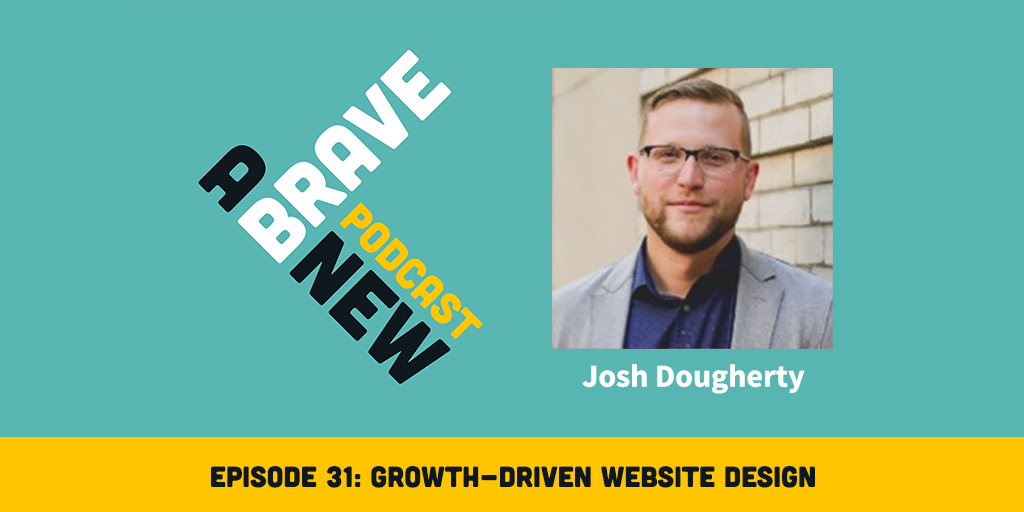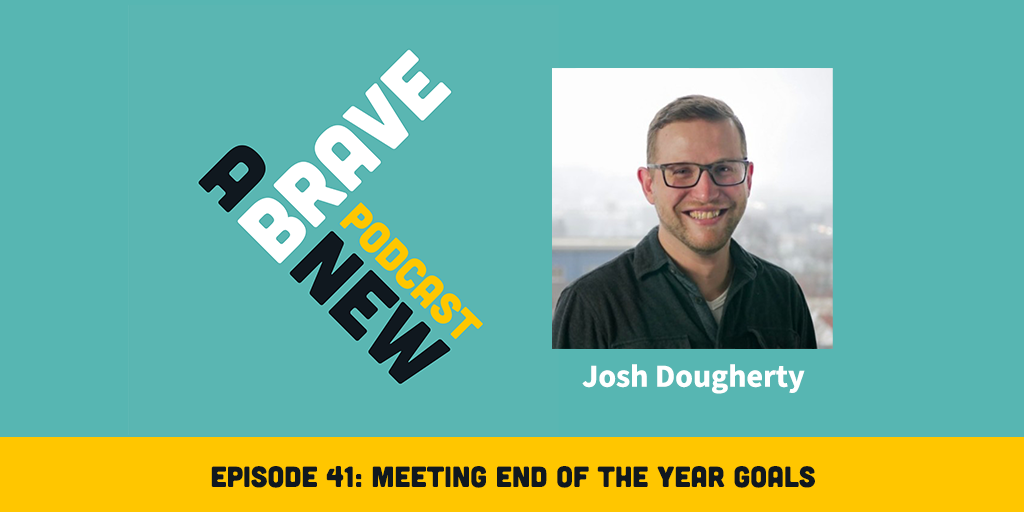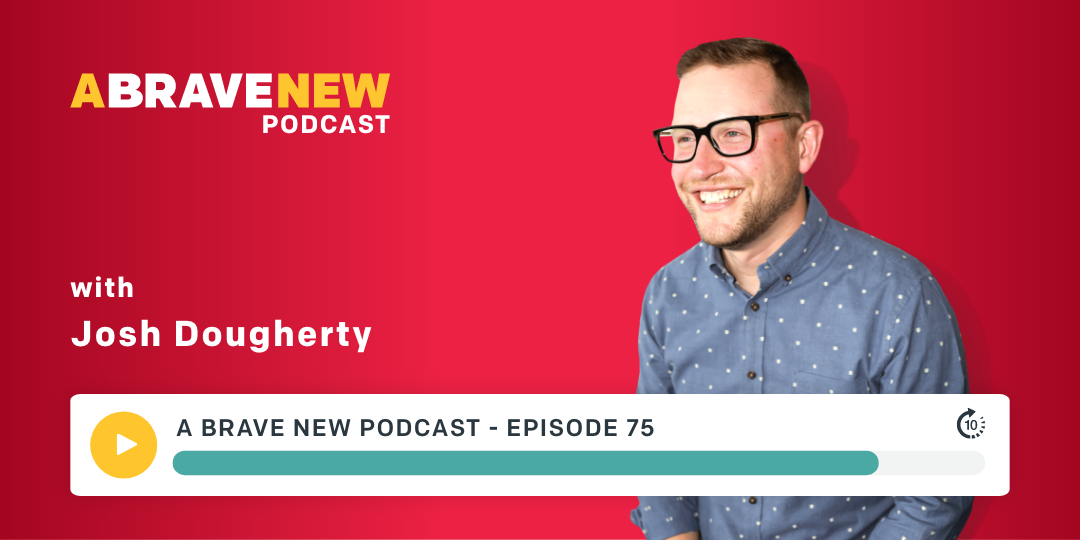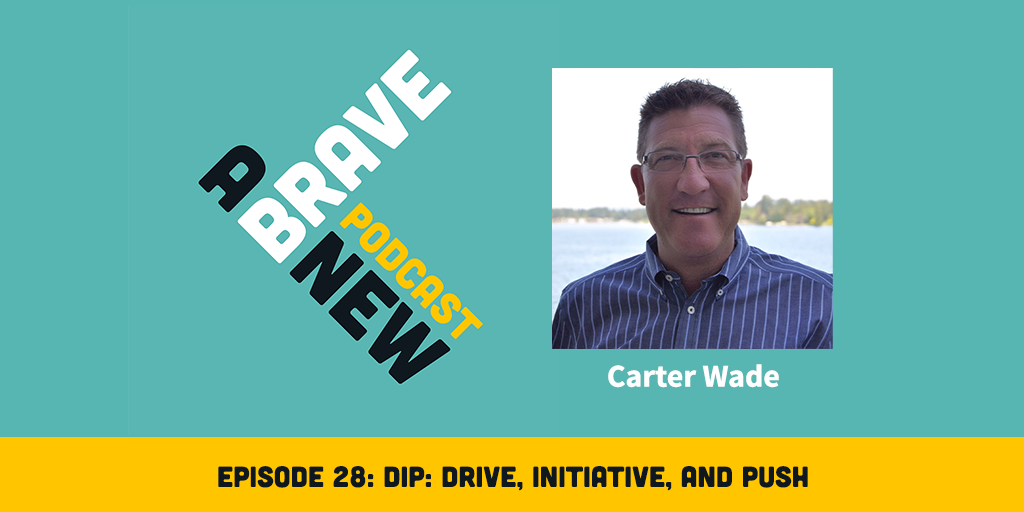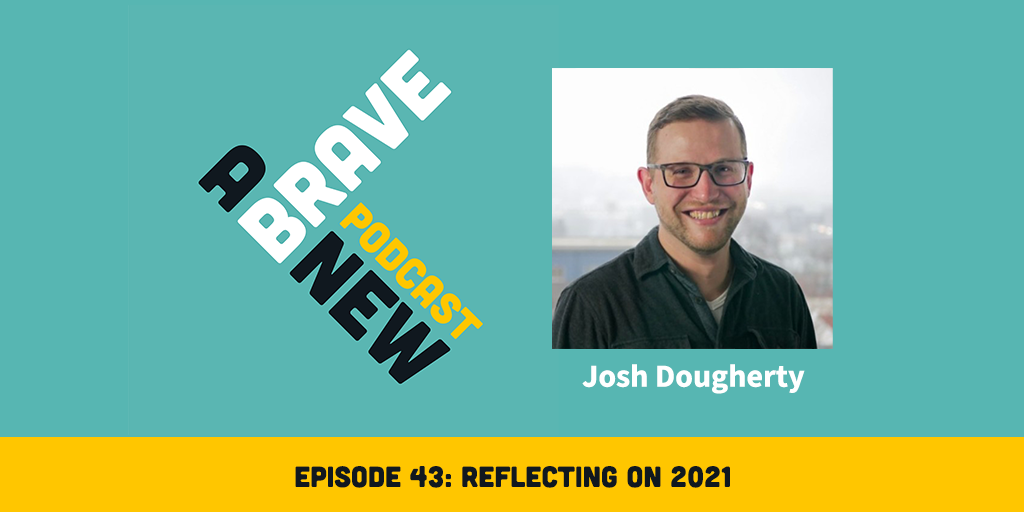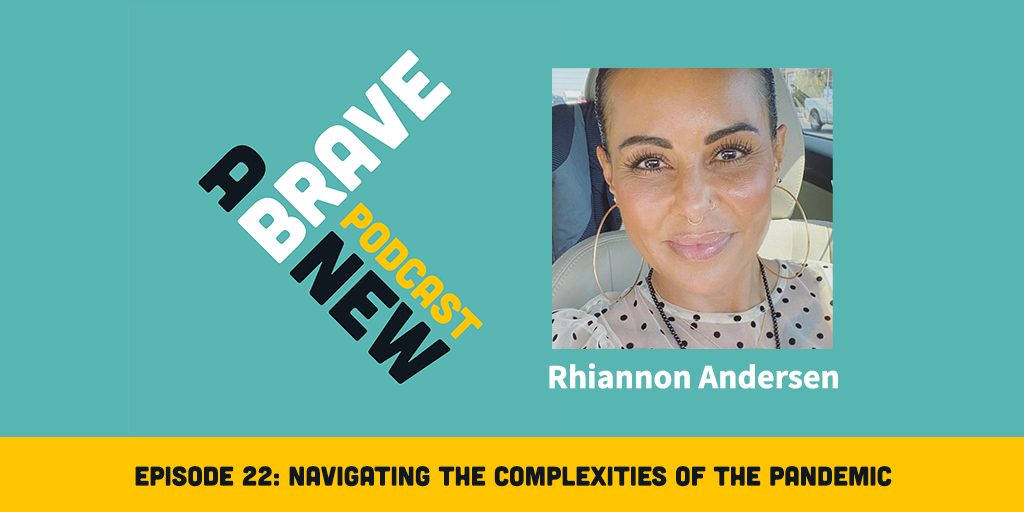Josh Dougherty is a brand strategist, speaker, and the founder and CEO of A Brave New, a Seattle-based B2B digital marketing agency specializing in tech and healthcare. Over the last decade plus, he’s worked with clients to develop unique brands and accelerate business growth using web design, inbound marketing, account-based marketing strategies.
What you’ll learn about in this episode:
- Why a disciplined band rollout process is necessary
- The length of time it will take to for people to start internalizing the brand and repeating it back to you
- The difference between brand and marketing
- Why a brand rollout must be treated as more than just a marketing campaign
- How to effectively roll out your brand to the two most important groups of people: your team and your customers
- The key elements of a brand implementation plan
- What to think about when planning and executing your internal and external launches
- How to leverage a content strategy and ongoing brand training to maintain momentum over the course of the first year after launch and into the future
- What do do if you realize that you’ve gone off course 3-5 years after your brand launch and once again sound like everyone else
Additional resources:
- How to effectively roll out your brand (blog post)
- The secret to an accelerated branding process (guide)
- Josh Dougherty on LinkedIn
- A Brave New’s Website
Transcription:
Intro: Welcome to A Brave New Podcast, the podcast all about how big ideas, brave thinking, and marketing smarts help businesses grow. Here is your host, Josh Dougherty.
Josh: Hi, I'm Josh Dougherty, your host, and welcome back to another episode of A Brave New Podcast. Today, we're going to dive into one of the finer points of branding, and that's brand rollout. I think we spend a lot of time going through how we build out the brand drivers or the main idea behind our brand, that unique memory we're trying to create. We spend a lot of time thinking about what is classically called the brand identity or your logo. We think about the visual system, we think about the messaging. But at the end of the day, we often overlook the rollout. And so, today, I want to dive into that a little bit, because oftentimes, we don't get to the finish line with our brand, and that stinks. You don't want to have that happen. So we may spend a year coming up with a concept, working through those visuals, working through the messaging, all the things I just mentioned. And then when you get to the moment of launch, you're exhausted and it's hard to keep pushing.
Now, an important caveat here that I'm not really talking about is maybe a Fortune 500 brand here, because those companies have the team, the resources, all those things to be able to roll out a brand really well. And they can do it, I think, over a long period of time because with budget, with additional people, comes the sustaining ability to do a brand implementation really well over time. This conversation is more for, maybe, that mid-size company, the company that we typically work with. Maybe have a 3- or 4-person marketing team, or a 15-person marketing team, but you're all busy. You're trying to get all your work done. You've taken on the brand project as an additional piece of work that is going to be super transformative to your company, but it's also going to be hard work and it's hard to fit it in around the edges of just keeping the ship moving at the same time.
So, if you find yourself in a team like that, and you've been investing in a brand identity process, building out what that unique concept, that unique memory at the center of your brand is, what we call the essence. You've created maybe a refreshed logo, maybe you've renamed yourself, maybe you've created that messaging platform. And now you're staring down at implementation. Let's discuss how you can do it effectively. The reason we're going to discuss this is because even if you've come up with the most brilliant brand possible, if it creates this amazing connection with your audience, you must implement it well or else all that work is for not. And in order to implement it well, you need to think beyond just a marketing campaign, because something I really want to instill in you in this conversation is that branding isn't marketing. Branding is something entirely different. And because of that, we need to approach it differently than we would a marketing campaign.
With brand, we're trying to build up this lasting idea, this memory, so that every time someone thinks about our company they remember something specific. And to build that memory up, you have to have stamina. And what that means is, many studies show that it takes 18 to 24 to 36 months for people to begin to respond back to you with messages in an unaided way. It requires massive repetition, and that type of repetition, and it requires a disciplined implementation process. Now, before I go in and talk about that implementation process, I'm going to make a slight aside in case you haven't started your branding process yet.
Because we know at the back end that a branding process is going to require that discipline for 18 months to 3 years to really get traction, we really like this idea of an accelerated branding process. This is a branding process that is completed maybe not in the typical year to year-and-a-half process that maybe a large branding agency would lead you through, but it's completed in like six months. It's focused on getting the big ideas right. It's focusing on getting the main idea behind the brand right, and then building out those elements around the brand and then implementing quickly. It's flexible. It maybe does just enough research to make sure that the brand is going to land effectively.
And this type of branding, we believe, works really well in the modern world because you may come up with a concept from a year ago, and you've worked on it, you're really excited about the brand. It may not be relevant if you wait a year and a half to launch it. And so, getting into implementation faster allows you to test whether your idea is sound, it allows you to start adjusting it. Always maintaining that core idea, but adjusting how you make that core idea show up throughout your organization more quickly. And it also does a key thing, it preserves your energy so that you can last 18 months to 3 years to be able to implement the brand.
So back to what implementation looks like. The key point I made a second ago is that we must remember when we journey into brand implementation that this isn't a marketing project. It's an investment in the long-term equity and the value of your company. We're trying to curate a unique memory that will connect your audience to your business. We're building lasting equity. We're focused on transforming not only how your organization messages about itself, but how it shows up altogether. We're focused on identifying what it's going to say yes to and what it's going to say no to. And so, we need to make sure that as we go through that we are being very intentional.
And so, before we dive into the nuts and bolts process, it's important to talk about what the key constituencies are for your brand implementation. Who are you trying to influence? There's one audience that you are definitely thinking about, and that's your target audience, the people you're selling to, your potential customers. Your brand has to build this really deep connection with those potential customers, right? It needs to, as per Fabian Geyrhalter, who I talked about a few weeks ago, your brand needs to have soul so that it connects with those people who are going to be your true fans.
But there's another audience that we often forget that's really, really, really vital to making sure that your brand actually impacts your potential customers or your current customers and that's your team. So as we go forward in this conversation, I want to emphasize that your team is just as important as your target audience, your potential customers, your customers, the people you're selling to. Your team is just as important as them in the brand rollout process. Now, you might be thinking, "What? Why would that be?" And so there's three really key reasons for that. First, they're the ones that are going to live out the brand. Old school branding world would talk about how the switchboard operator, when you used to have a switchboard operator in a company who would connect phone lines, was the most important brand ambassador because they talked to the most people.
Well, this concept still lies true here. If you have consultants and your company is focused on consulting or on sales or on building out strategies for people, if those consultants, strategists, salespeople don't live out the brand, your brand isn't going to show up the way you need. If you have a consumer brand where people are coming into a store, if your employees, who talk to people, when they come into the store can't live out the brand, your implementation is going to fail. So these are the people that are going to live out the brand. They're the ones that have to embody it.
And I think more importantly than anything, they have to embody it in an authentic way. So we need to structure our implementation in such a way that we can get our team thinking about, "Oh, here's the key memory, the key essence at the middle of the brand. Here's how I would live it out in my day-to-day work, and here's how I would live it out in a way that feels authentic to me so that it sticks." And at the end of the day, they're the ones that are going to make sure the idea spreads. In addition to maybe having all the amazing things that you need, like great marketing, a great website, some great experiences tied to your brand, we need to get these people on board. So that's why we're going to focus here on the internal launch just as much as the external launch.
So let's dive in now and talk about the actual process, and I'm going to walk through step by step. You can take notes if you want to while you're listening or just breathe it in. But the step-by-step process is really interesting. The first thing that we're going to do before we even get going is we're going to create an implementation plan. And this may seem silly to talk about or silly to even mention because, of course, you need a plan if you're launching a brand, but sometimes people move on without it and they end up getting lost halfway through the process.
So when I'm building out my implementation plan, I like to initially plan out probably from the 90 days before launch all the way through to maybe 6 months after launch. And I'm going to think about splitting that implementation plan up into three things: the pre-launch activities that we're going to do getting ready up to an internal launch; then the activities that I'm going to do up to the initial external launch; and then probably the first, I don't know, four or five months after that launch, that external launch where the entire world knows about the brand.
And then we're going to take some stuff afterwards. We're going to use a tool called editorial planning, called content strategy, to think about how we take the brand on beyond that six- month period, but that's not really the purview of this conversation. We'll get into it a little bit at the end. So we read out an implementation plan, and in that implementation plan, I think we want to focus step by step on what are the key tactics that we're going to do during that time., Who are the people we need to influence and win over? What are the specific events we're going to hold? How’re we going to communicate to the public or to our team? So, really, this is meant to be pretty tactical. It's strategic in that we're following a framework of pre-launch, internal launch, external launch, and post launch, but we want to think through all the details.
And in the pre-launch phase, there's a couple things we're going to do. To keep it simple, we're going to think about, well, three key things. First, who are the people that have influence in our organization? So, you're sitting around the table and you're maybe a r4- to 5- to 10-person marketing team, and depending on the size of your organization, it's going to be really hard for you to influence the rest of the organization around the brand. And the temptation is always to say, well, the C-suite, they're going to share down the brand, everyone's going to get on board, it's going to be amazing. And that will almost uniformly fail. So, what we want to think about are those people who have influence. Some of them will be people who are high up in the organization, but some of them might be people who are in entry level jobs, or really low-level jobs, but they know how to influence the people around them. You probably know who they are. The best of them will influence those around them in a really positive way.
And then there's the Eeyores, who are going to, I don't know, downplay or even talk badly about any change, which a brand is inevitably change, a rebrand is inevitably change. And these Eeyores have a way of winning people over to their negative way of looking at things. So you may be thinking about your organization and coming up in your head with here are the people who can really help influence positive change, here are the people that can scuttle an idea if they're not on board, and here are the high-level leadership that have a lot of influence throughout the organization.
What we want to do in the pre-launch phase is identify and recruit all those people as brand ambassadors. Yep, even the ones who can scuttle the idea, because if we can win them over, we can win anyone over. And we're going to bring them together, and we're going to do some training, and we're going to help them understand what are the one or two or three unique ways that they can live out the brand in their day-to-day work. We're going to enlist them to help them understand the brand platform, the brand drivers, the essence, all the different things that we're trying to convey with the brand so that they can go back and share that with the people that they work with. We're also going to enlist them in helping us do training with their coworkers so that they can help us get other people on board.
The key thing with these brand ambassadors is that we want to create a team that's more than yourself: a team of influencers. They're going to be able to work together with the core team that's managing the brand to ensure that it gets adopted throughout the organization. So, that's the first thing we're going to do in the pre-launch. The second thing we're going to do in the pre-launch is we're going to do any planning for internal marketing campaigns you're going to do; your brand launch event, any collateral you need to create for that; probably a brand launch video that you want to create, because I don't think you can really launch something without that today; and also any swag that you want, to really get people on board. And I encourage you, during this time, to really spend some time thinking about all those elements.
And then the final thing we're going to do is really refine our brand filter. Our brand filter is typically five questions that we can ask to understand if things are on brand or off brand, and we want to give this to people to help them make decisions about, Am I living out the brand effectively? So we really want to think through that brand filter and also think through what are some easy branded behaviors—things that people can do to live out the brand—to give them some really practical ways to make the brand come to life. So you've done that, thought about your ambassadors, you've thought about all the tactical stuff you need to do, you've worked on your brand filter, you've talked about branded behaviors, now you're ready for internal launch. So you've done a lot of work to get ready for this.
In the internal launch, I'd encourage you to think of it as being just as big and splashy as an external launch. If you're a mid-size company, it's a great time to bring everyone together, make it feel like a party, create some suspense around what's going to happen, about what's being announced, and then put together a presentation that's a show. Every great brand is an experience. And this is your first chance to think about, okay, we want to be remembered in a specific way, let's create an experience that starts building that memory. And then we're going to show the brand launch video. We're going to have a big unveiling and make our team feel so special that we put so much thought into this new brand. And then we're going to leave them with some practical things that they can take back that immediately are mementos of the brand. Some of this will be swag. Some of this will be things that they can actually do or things that they can think through to help them live out the brand better. But after that big internal launch event, your job's not over.
Now it's time to do training. So we're going to recommend, before you do the external launch, you should do training after that internal launch with every single department in your company, every person in the organization. And those trainings can be pretty simple, but they're all about helping people internalize, What does this brand mean to me? So, at A Brave New, we're all about helping brands be remembered. We would ask people, "How can you integrate this idea of I'm trying to create and help brands be remembered into my day-to-day work?" And during the training, we're going to spend time, maybe an hour, of small groups working together, brainstorming about that, trying to come up with practical ways that they can live out this brand essence, practical ways that they can curate this memory themselves, ways that feel true to them. And then we're going to come together and share all of those.
And oftentimes when people do that, they come into this training, they're like, "Ah, it's just another idea. I don't know how this would change what I do. I don't know how I would look at things differently." And then around the table, people go reading out the things that they're going to do differently as a result of the brand, and light bulbs start to go on. So, we're going to do that training and we're going to repeat, maybe have a monthly brand training where we get together and have conversations. This isn't about lecturing. This is a time to work together to understand what it doesn't mean to live out the brand, maybe a small bit of a reminder about what the brand is and how it's supposed to look when we get together, maybe some conversation around the brand of behaviors, the specific ways we want people to live out the brand.
But overall, we want all those trainings, as you go through, and I recommend continuing on a monthly or quarterly basis for the first year after the internal launch. We want those to be about working sessions, about people bringing their own voice to the brand, understanding how do I uniquely live out this brand while also accurately reflecting the essence of the core memory in the middle of the brand, at the center of the brand.
So once we've done this internal launch, we've done some work on training, people are excited, people are ready to live out the brand, then we're going to do an external launch. And there's going to be marketing components to it. You're probably going to make a big splash on your website. You're probably, if you have physical spaces, you're going to transform your physical spaces with your new look and feel. You might hold an event, if you're that type of company. You probably will send out a press release. You'll probably release a blog. You'll probably do some advertising, do some sort of campaign. You might create something special to give to your customers as a reminder or as an introduction to the new brand. But you need to think about how the experience is not just marketing.
So you also need to think about, "Okay, when we launch this new brand externally, well, how do our recruitment processes change? How do we change how we're doing accounting because we're trying to live out the brand? How do we change our accounts payable? Does it change? How do we adjust our software development process? How do we change how we're selling? How do we even change how we're doing presentations?" These are the big questions. And we need to think about these before that external launch, because at the end of the day, we want someone to land on our website and see, "Oh my God, the look is changed, but it also feels different. All of a sudden, I have this entirely different emotional connection to this company."
But then when they talk to someone, like maybe if this is a customer, they land on your site, they're blown away, maybe they get a special package that introduces your brand. The feeling is really exceptional. People are feeling attracted. They're feeling this connection with you. That has to be followed through with the next conversation they have with someone in your organization, or even if it's accounting following up about an overdue invoice. They need to be like, "Oh my God, these guys are actually taking this seriously. It's changing everything about how they do it, their work, and how they show up in the world." That's what great brands do, they transform themselves. And I think if you're thinking, "Oh my gosh, how do we completely change the script on how we're doing our work," I want to encourage you here to think back to about what we always talk about, about brand.
Your brand isn't entirely new. Oftentimes when we're refreshing a brand, versus creating a brand from scratch, we're refining it, we're refocusing it. It's going to be 50% who you are now, 50% of where you're trying to go. And so you don't need to worry about whether this is going to feel completely dissonant. It should feel, in some ways, to your customers—the people who already know you—comfortable but better than it was before. A little bit like they're being drawn in a different, new way. And with the new people, it doesn't matter. They've never experienced you, so they're just going to know the new brand.
So, you're going to do your external launch. And one thing I want to encourage you here is there's a real temptation to change over absolutely everything at once when you do your external launch. All your old stationery, all your old physical things, et cetera. And that can be a lot of work. Maybe it's hard to get that sign changed on the front of your building on day one. So I want to encourage you to be a little bit flexible and to think about where we are going to change the highest impact places with the external launch, and maybe we'll wait on a couple other things. Now, if you can do it all at once, I encourage you to do it all at once. I'm just letting you know that there can be flexibility.
You're definitely going to want to change, on that day of the new launch, your website, your social media channels, key brand experience touch points in the physical world, maybe email signatures, presentation decks, stuff that are key touch points. But there's stuff that hangs out there that maybe you have, like some letterhead that you printed out that you're going to keep using to do, I don't know, AP work on until you run out. Maybe you have a couple elements that can stick around for a while, and just work over the next 90 days to replace them.
So then, what we're going to do after this external launch is you're going to have to spend time in your implementation plan marking out what are those touch points we're going to hit. And, also, what are the things that we're going to change 90 days after launch or begin working on because we've started to implement the brand effectively? And so, just work that plan for those first 90 days, focus on if you left stuff that you didn't fully roll out the new brand when you had your external launch, focus on rolling it out to the rest of the elements of the organization so by 90 days out, when someone looks at you, they only see the brand new. And then, the hard work begins, because the excitement is gone. You're no longer launching a new brand. You've launched. And you're really sick of what you're talking about, because you've been thinking about the brand for however long you spent developing it and through this rollout, and you're really tired.
So now it's important to build in some systems to keep yourself accountable. We like to use content strategy to do that. So content strategy, as we classically think about it, is a combination of both messaging discipline—understanding the life cycle of content, of your workflow for creating content—and how you govern to make sure you're creating the right content. And so we recommend implementing a content strategy that has thought thoroughly through how each element, each communication channel, each outbound touch point will reflect the brand and is thought through the workflow for making sure that new content or those outbound communications can match the brand and governance to make sure that not only are you able to create this stuff, but you have someone reviewing to make sure the brand is shining through in everything you're doing.
And once that content strategy is in place, we recommend doing monthly or quarterly editorial planning to sit down each month and look at the map of everything that's going to be done, both for marketing and experiences, and all these sort of things, and say, "Okay, how do we make sure we're telling the same narrative, we're following the narrative arcs that we laid out in the content strategy, we're hitting the key notes about our brand essence and about the attributes behind our brand so that we're becoming more memorable. We're not running off and chasing after that shiny new campaign, changing our messaging." So you're going to use editorial planning as a way to consistently come back month after month after month after month and make sure that you're living out the brand in a consistent and clear way. I just said month after month after month after month like it's such a drag. Sometimes it will be, sometimes it'll be really great though. It's all about building in that discipline so that you can have the creativity within the boundaries of your overall brand.
And as you're doing the editorial planning to control the outbound messaging and the outbound communication, we also recommend that you would continue to do brand touch points with each person on the team for a year, at least. Well, each person is a little bit strong, probably, but each department or each team. You do touch points with them, maybe you do a training quarterly to sit back and say, "Okay, how did we live out the brand well over the last quarter? What could we do better next quarter? What are some ideas of new ways we could express the brand that are still true to the core idea, the core essence behind the brand?" So editorial planning to make sure your marketing communication stuff stays on point, internal training to make sure that people are continuing to think about it.
And there you go, you're on your way. Now you just have to be consistent. You have to live it out. And over time, you're going to have people start to respond back to you and say, "Oh yeah, you're the company that does that. At A Brave New, you're the company that helps B2B firms be remembered," but it takes consistent repetition to get there. And before I leave today, I think I want to dive into one last thing because maybe you've been through this process. Maybe you rolled out your new brand and you're waking up three and a half, four, or five years later, and you're saying, "Oh my God, we've gone astray. We look like everyone else again. We just regressed to the mean," and my encouragement to you is that it's never too late to go back and begin to work on that differentiation. You have the benefit that many people don't have because you already went through that branding process, you identified the unique elements, the core essence, the memory at the center of your brand.
So it's never too late. Go back, revisit that essence, revisit the brand drivers, revisit all your plans, and then identify how you're going to bring things back in line. And make small steps. Don't beat yourself up. Don't say, "We've got to change everything overnight." You got off course over time making small steps, and now you can put yourself back on course making small steps so that you're living out the brand effectively. Just make sure you take that next step, and the next one after that, and the next one after that.
Okay. Well, I hope that this has been really helpful. I hope that you're excited to focus on your brand rollout, not just the development of the new brand. I think this is where the magic happens, this is where the rubber hits the road, and this is where we get a chance to make a real difference with our organizations. Thanks so much for joining me today. I hope that you enjoyed the conversation. You can hit me up on LinkedIn or on Twitter if you want to continue the conversation. And until next time, I'm Josh Dougherty, your host. I hope I'll see you on the next A Brave New Podcast.
Outro: Thanks for listening to this episode of A Brave New Podcast. Go to abravenew.com for more resources and advice. If you enjoyed this episode, show us some love by subscribing, rating, and reviewing A Brave New Podcast wherever you listen to your podcasts.
Similar Articles
OCT 11, 2021

The Beginner’s Guide to Generating Inbound Leads
Marketing doesn’t have to be painfully intrusive, like getting yet another telemarketing call right when you sit down to dinner with your family.
OCT 11, 2021

The Beginner’s Guide to Generating Inbound Leads
Marketing doesn’t have to be painfully intrusive, like getting yet another telemarketing call right when you sit down to dinner with your family.


